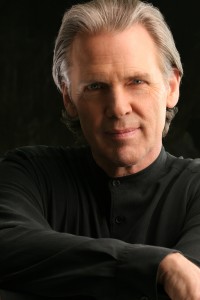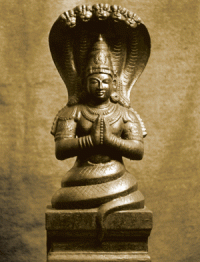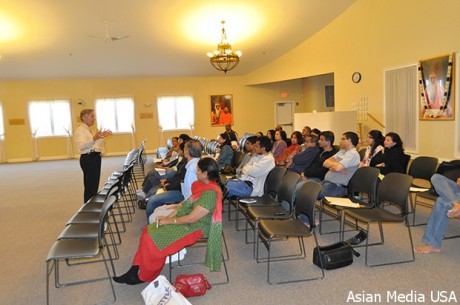From: Ishwar Sharan <ishwarsharan@gmail.com>
Date: Sun, Apr 28, 2013 at 10:10 AM
Subject: [New Post With Comments] Jeffrey Armstrong teaches the Hindu diaspora how to explain Dharma to hostile Americans – Asian Media USA
To:
Jeffrey Armstrong teaches the Hindu diaspora how to explain Dharma to hostile Americans – Asian Media USA
 Chicago IL: World Hindu Youth (WHY) association hosted a seminar on "Reframing Bharat" followed by another on a "New vocabulary to describe Vedic dharma" on Saturday, April 20, 2013, at Chinmaya Mission Badri campus located at 11S080 Kingery Hwy, Willowbrook, IL 60527. Presented by best-selling author Jeffrey Armstrong, also known as Kavindra Rishi, from Vancouver, the seminars aim to teach the younger generation how to speak confidently about Hindu dharma especially to its detractors. Vidya Naha of WHY presented Armstrong as a Vedantic seeker. He is also a poet and astrologer or "karma mechanic" as he also puts it.
Chicago IL: World Hindu Youth (WHY) association hosted a seminar on "Reframing Bharat" followed by another on a "New vocabulary to describe Vedic dharma" on Saturday, April 20, 2013, at Chinmaya Mission Badri campus located at 11S080 Kingery Hwy, Willowbrook, IL 60527. Presented by best-selling author Jeffrey Armstrong, also known as Kavindra Rishi, from Vancouver, the seminars aim to teach the younger generation how to speak confidently about Hindu dharma especially to its detractors. Vidya Naha of WHY presented Armstrong as a Vedantic seeker. He is also a poet and astrologer or "karma mechanic" as he also puts it.
Starting with a prayer to Ganesha and invocation to the Guru, Armstrong immediately presented his unique credentials, as an American convert, to teach often bewildered Hindus-by-birth. Attracted by India's patterns of thinking and feeling, and its compassionate culture, he soon became a "why" specialist, for "all the subjects I studied (language, psychology, science, etc.) took me to India." As an outsider, he had to think through all these alien concepts and behavior from the foundations up, unable to take anything for granted. Whereas his Christian teachers never encouraged questions, the question-answer format is at the core of Hindu transmission.
"I gave up my family, church, and culture to become a Hindu, but ended up being more alone without a community. You don't have to study, whereas I have to because of my situation. Hindu culture is partly asleep, whereas I am awake. Everyone is asking the youth why they are Hindu, a question their elders are not able to answer in English. This is what I'm able to do. I've been working with Hindu youth in both the USA and India for the past 14 years."
The Hindu diaspora is at a disadvantage when having to explain their dharma to often skeptical, if not outright hostile, Americans because the weight of the English vocabulary is pitted against them even before the discussion can get started. Youth are especially vulnerable because the parents are not equipped to translate their beliefs into language that makes sense within the worldview and language acquired here through schooling. The whiteboard already listed a wide range of inherited (English) "Words to Avoid" as opposed to (Sanskrit) "Words to Understand."
 Because the person who keeps asking the questions retains control, we need to disorient our interlocutor by changing the subject. When asked "why do you Hindus have so many gods?" we could start talking about the icons on his desktop and compare them to "idols" that are different from programs, yet help keeps things organized, etc., point out that invoking the name of the god is like clicking on the icon to accomplish a task through the underlying code. Armstrong resorted to many such extended, often unexpected, metaphors to bring home his lessons.
Because the person who keeps asking the questions retains control, we need to disorient our interlocutor by changing the subject. When asked "why do you Hindus have so many gods?" we could start talking about the icons on his desktop and compare them to "idols" that are different from programs, yet help keeps things organized, etc., point out that invoking the name of the god is like clicking on the icon to accomplish a task through the underlying code. Armstrong resorted to many such extended, often unexpected, metaphors to bring home his lessons.
Armstrong gave many examples of how to think, question, and use words strategically instead of falling into the opponent's trap by directly attacking him. The trick is to reframe the whole debate in unexpected ways that intrigue the listener into wanting to follow your own story and thought processes and thereby see the world differently. Piling up facts will in itself not convince a person who holds a different worldview. Participants were distributed a sheet summarizing such "Rules of Framing" adapted from the book Don't Think of an Elephant by George Lakoff, language strategist at University of Berkeley.
The second workshop addressed the pitfalls of mapping familiar Western concepts to Hindu traditional terminology. Armstrong explained why dharma is not religion, Bhagavan is not God, yoga is not faith, devas are not gods, murthis are not idols, namah is not worship, papa is not sin, svarga is not heaven, and other such facile equivalences. The secret is to know whom you are talking to; and to ask oneself "am I a living example of what I believe in?" Most Hindus have received their tradition in bits and pieces but have not yet been initiated, which is like not installing the downloaded software and then calling tech support, i.e., the guru, to complain. Instead we "need to produce hundreds of Vivekananda's by teaching people how to speak strategically about one's own culture and traditions."
Armstrong also attacked the "sameness" syndrome preached by many Hindus. All religions are not the same but more akin competing operating systems, like Microsoft Windows versus Apple, each with its own terminology and underlying philosophy. The Christian operating system is much poorer in vocabulary, as evidenced by the smaller list of words to avoid. The British purposely replaced Sanskrit with English language, thereby limiting the vocabulary for discourse about oneself. Abrahamic world view was never interested in the world and matter, unlike the elaborate treatment of prakriti (nature) in Hinduism. There are already many Sanskrit words in English, and one of the greatest gifts that Vedic culture can give the world is its richer vocabulary. Armstrong wondered why no Hindu has ever approached him to try and explain the universe in terms of the permutations of the three gunas (sattva, rajas, and tamas) and defects (dosha) to outsiders, and went on to explain the notion of devas in considerable detail.
 He ended by decoding the sophisticated vocabulary of Patanjali's Yoga Sūtras of mind-stuff (citta), its modifications, (vrtti) psychic traces (vasana), our inherent nature (svarupa), etc. He opposed its scientific approach to "religion" from "re-ligare" (Latin), which is to be "bound by rules," i.e., do as you are told with no questioning). This is the source of the "religious" conflict we see today around the world. Paramatma (Supreme Self) is the single cohesive all-pervading consciousness that holds everything together including the separate individual consciousnesses (atma). Goal of yoga is to "plug into paramatma" by first realizing your own atman (through citta-vrtti-nirodhah). "I've been 'programming' with these words," Armstrong affirmed.
He ended by decoding the sophisticated vocabulary of Patanjali's Yoga Sūtras of mind-stuff (citta), its modifications, (vrtti) psychic traces (vasana), our inherent nature (svarupa), etc. He opposed its scientific approach to "religion" from "re-ligare" (Latin), which is to be "bound by rules," i.e., do as you are told with no questioning). This is the source of the "religious" conflict we see today around the world. Paramatma (Supreme Self) is the single cohesive all-pervading consciousness that holds everything together including the separate individual consciousnesses (atma). Goal of yoga is to "plug into paramatma" by first realizing your own atman (through citta-vrtti-nirodhah). "I've been 'programming' with these words," Armstrong affirmed.
Armstrong's examples, especially his (pseudo-) etymologies and proposed 'kinships' between English and Sanskrit, became funnier as the workshop progressed such that the chuckling students were sometimes uncertain whether he was (half-) joking. In truth, he was skillfully using humor to entice the audience into thinking differently and more deeply about the words and concepts we have inherited without reflecting. Questioned about this technique, he told Asian Media USA that in his previous life he was a standup comedian regularly invited by the corporate world and paid handsomely to teach them to see the 'religious' side of IT and laugh!
The seminars were repeated the next day on a larger scale at the Chinmaya Mission's Yamunotri camp at Gray's Lake. Two of his volumes were on sale during the workshops. – Asian Media USA, 24 April 2013
Filed under: christianity, devatas, hindu, hindutva, iconography, india, monotheism,panentheism, philosophy, polytheism, psychological warfare, psychology, religion,rituals, sanskritisation, values, vedanta, yoga Tagged: | abrahamic religions, devatas,gods | goddesses, hindu defence, hinduism, indian diaspora, jeffery armstrong,panentheism, politics, polytheism, religion, sanskrit, sanskritisation, western monotheistic religions, yoga
3 Responses
- gajanan, on April 28, 2013 at 8:47 AM said: Edit Comment
John Dobson, still alive 98 yrs, was a monk in Ramakrishna Mission California. He has written an excellent book "Advaita Vedanta and Modern Science" in which he has written the following. Swamiji here is Swami Vivekananda. Dobson invented the amateur telescope the reason for him to leave his monk status from RK Mission. Here is an extract from "Advaita Vedanta and Modern Science"
"For thousands of years the Indian mind has lived and thought philosophy. In India Swamiji found a language ready-made for handling philosophical ideas. There is no language on the face of the earth even comparable to Sanskrit in its competence to handle philosophical concepts. Swamiji found himself translating and re-translating from Sanskrit to English. In English there is no word for Vivartavada (the doctrine that the first cause is apparitional). Parinama (transformation) is understood but not Vivarta. There is no word for Brahman, for Atman, for Maya or for the Gunas. It is not just that the words are absent; the ideas are also absent" — J Dobson.
Very true, John Dobson has said with great eruditenes. It is futile to translate Sanskrit words and mislead the public if you are doing the wrong interpretation. All the so-called men who translated like Max Mueller, Ralph Griffits etc were full of ignorance as John Dobson has written that even the ideas were absent in English, then how can you give the right translation. Max Mueller never came to India. The translations were all done with pundits who knew not even rudimentary English and the westerners ill equipped in Sanskrit.
There was an article written in http://www.vijayvaani.com/ArticleDisplay.aspx?aid=2650 Come Carpentier de Gourdon where he wrote Brahman means father.
This was a very bad translation to which I protested. Just read George Augustines response in the article by Come Carpentier de Gourdon. It is very interesting.
So as John Dobson says do not translate these philosophical concepts as these concepts do not exist in other languages. This is the reason for such disastrous interpretations and all this nonsense.
- IS, on April 28, 2013 at 9:50 AM said: Edit Comment
Come Carpentier's article caused a great controversy. It was a very clever piece of Christian inculturation propaganda. It is inexplicable why Sandhya Jain published it. And when the matter was brought to her attention by Shree Vinekar and others, she showed extraordinary contempt for her readers by refusing to even discuss the matter.
Even more extraordinary was that Hindu public intellectuals like Radha Rajan and Vijaya Rajiva came to her defence and said she could publish what she liked and if we didn't like it, too bad for us!
Had I published such an article on Bharata Bharati, these Hindutva harpies would have hung me and had me drawn and quartered. They had already identified me as a "white dog" (Sandhya Jain) and a Christian agent planted in the Hindu Sangh (Radha Rajan) because I had published an article by Dr. Elst which they didn't understand and therefore didn't like. Hindutva intellectuals–I use the term intellectual loosely–are racist and not very bright. Dr. Elst runs circles around them and they resent it deeply.
I have no tolerance for racism or for the double standards exhibited by these ladies, so I have stopped publishing them.
To get back to Come Carpentier, his identification of Brahman with the Christian Father is not new. It was done a hundred years ago in the North-East by Baptist missionaries when they were proselytising the Mizoram tribes. Now they usually identify Brahman with Prajapati as the equivalent to the Christian creator god.
All this is just nonsense of course. Brahman is neither God or a God. At best in English the 'It' — which cannot be known or defined — can be called Godhead, the source of God and Gods and everything else. But in fact the concept of Brahman just doesn't exist in the Western Christian brain at all.
We must use Sanskrit terms as much as possible. One of the great mistakes the early Hindu sadhus who went abroad made was to try to find Christian equivalents for Hindu concepts. Yogananda was the worst offender and ended up a Christian himself! Vivekananda was also rather too generous with his Christian interlocutors sometimes. Because of historical circumstances and the fact that India had been invaded by Muslims and then colonised by Christians, Christianity became the standard Hinduism was measured against. Ram Swarup and Sita Ram Goel worked very hard to reverse this process. They both insisted that Christianity and Islam are to be measured against Hindu standards–and not the other way round.
When Christianity and Islam are measured against Hindu standards, they fail miserably. They are not religions in the spiritual sense at all. They are political ideologies masquerading as religion. They do not seek God but world empire. Hindus must stop equating them with their own Dharma if they want to survive spiritually, as a unique civilization that has been badly damaged but not yet conquered.
- IS, on April 28, 2013 at 7:26 AM said: Edit Comment
English is a Christian language and English terms cannot carry the meaning and nuances of Sanskrit terms. Therefore Hinduism should be explained in Sanskrit terms as much as possible.
There is simply no relationship between the Abrahamic religions and Hindu Dharma. But because of historical circumstances, Hindus have had to describe themselves and their Dharma in English Christian terms.
But this does not have to continue. English is a marvellous language in that it absorbs foreign words and terms very easily so long as English-speakers use them. So we must use Sanskrit terms to describe our religion/dharma as much as possible.
sent from samsung galaxy note, so please excuse brevity

1 comment:
if you want to explain hindu dharma in english, you will inevitably fall into the paradigms created by the brits/church/marxists/secularists which were intended to denigrate hindusim. any surprise that most 'educated' hindus are confused with their religion?
Post a Comment